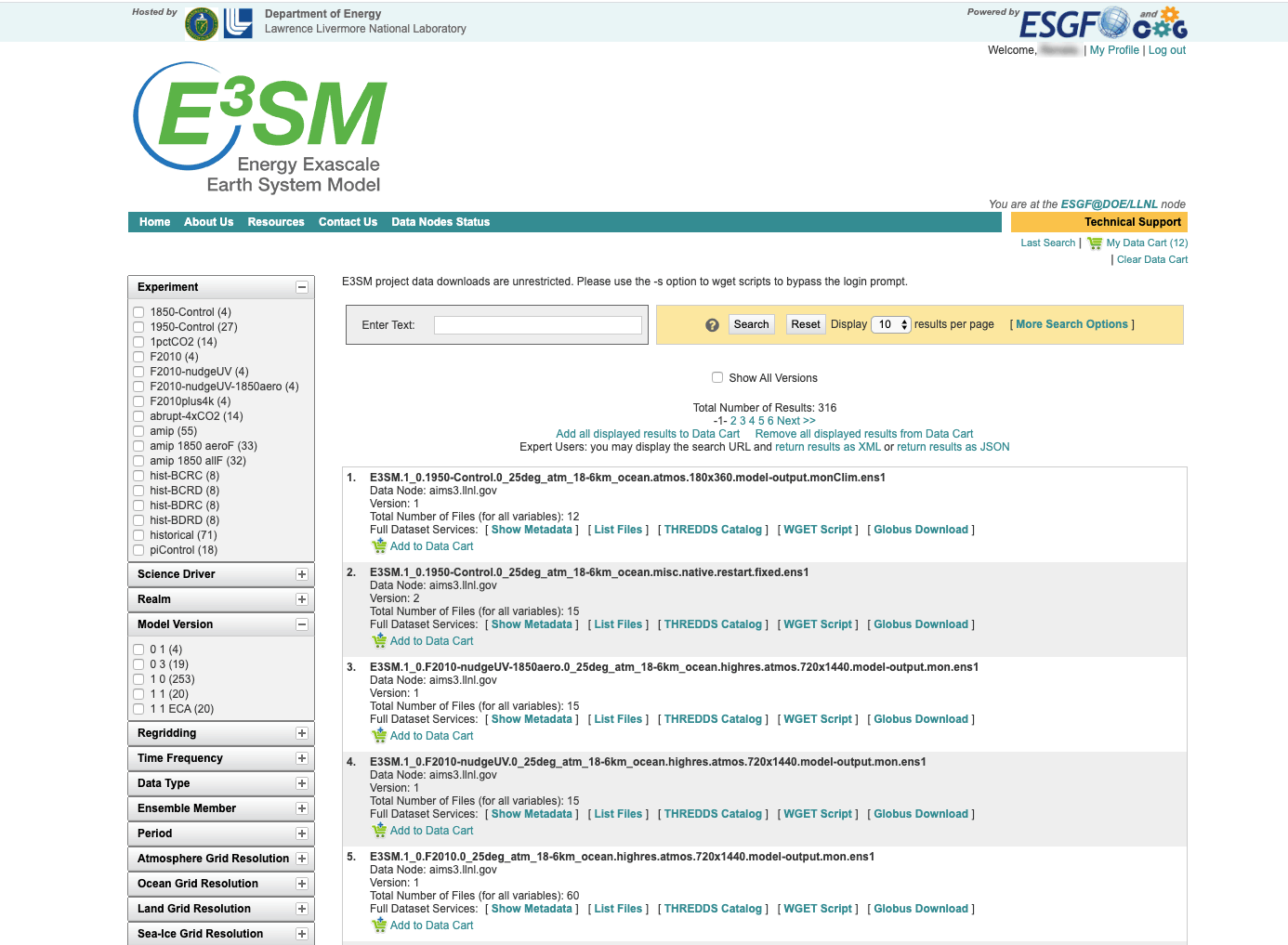High-Res and BGC Data Published to ESGF

The high-res simulation campaign is based on the E3SM code version v1.0. Its flagship calculation is a 50-year-long high-resolution simulation with time-invariant 1950 forcings following the HighResMIP CMIP6 protocol (“1950-Control”). To assess model sensitivity to anthropogenic GHG and aerosol changes, short simulations with prescribed sea surface temperature and sea ice extent were also performed. For historical reasons, such simulations are referred to as “F” cases. To isolate the effect of resolution, each of these runs (“1950-Control” and all “F” runs) were repeated at standard resolution. For F cases, these standard-resolution simulations were performed using both the parameter settings for the high-resolution model and separately with the parameter values from the standard-resolution release. Standard- and high-resolution configurations have different parameter settings to compensate for the effect of resolution change on model behavior. For details, see the high-resolution overview paper by see Caldwell et al., 2019.
The Biogeochemical Cycles simulation campaign was based on E3SM version v1.1 with two configurations representing different land soil BGC approaches. In standard configuration (“v1.1”) the Converging Trophic Cascade (CTC) biogeochemistry framework was used. The second configuration (“v1.1-ECA”) was an experimental configuration using the Equilibrium Chemical Approximation (ECA) (see “V1 Land and Energy” page for more details). For each configuration 5 experiments were performed. The first one was the pre-industrial control (“piControl”) with perpetual 1850 forcing. The remaining experiments were four “historical” runs that allows for changing forcing according to historical record and spanning 1850-2014. Those experiments are designated: BCRD, BCRD, BDRC, and BDRD. The “C” in the simulation name stands for “constant” meaning CO2 concentrations are held constant throughout the model run while “D” stands for “diagnostic” meaning CO2 concentrations follow historical trajectories between 1850 and 2014. The “B” stands for biogeochemical and refers to the CO2 concentrations seen by the land, ocean and ice models as either constant (BC) or increasing over time from 1850 to 2014 (BD). The “R” stands for radiative and refers to the CO2 concentrations seen by the atmospheric model. Hence, for example, the BDRD simulation, with CO2 concentrations following historical trajectories for the land, ocean and ice as well as the atmosphere, is a fully concentration-driven simulation showing both radiative and biogeochemical climate responses to CO2.
All the available data was published to ESGF into the E3SM project. A subset of that data was post processes (‘CMORized’) to adhere to the CMIP6 format and published to the CMIP6 data holdings in ESGF. Overall, nearly 300TB of data was published to the E3SM project on ESGF.
Available Campaigns and Experiments
The following E3SM-v1 campaigns data are now available:
- CMIP6 DECK Low-Resolution, v1.0 Water Cycle (1 deg) (designated as “DECK-v1.0” data below, configuration description ‘V1 1 deg CMIP6’ )
- piControl (1850)
- Historical (5 ensembles)
- abrupt-4xCO2
- 1pctCO2
- AMIP (3 ensembles)
- AMIP 1850 allF (3 ensembles)
- AMIP 1850 aeroF (3 ensembles)
- High-Resolution, v1.0 Water Cycle HiResMIP (0.25 deg) (designated as “HiResMIP-v1.0” data below, configuration description ‘V1 High-Res 1950-Control’)
- 1950-Control
- F2010
- F2010-nudgeUV
- F2010-nudgeUV-1850aero
- F2010plus4k
- Biogeochemical Cycle campaign, v1.1 (version with CTC) (1 deg) (designated as “BGC-v1.1” data below, configuration description ‘v1 BGC and Energy’)
- piControl CNTL CTC (1850)
- Historical BDRC CTC
- Historical BCRC CTC
- Historical BDRD CTC
- Historical BCRD CTC
- Biogeochemical Cycle campaign, v1.1-ECA (experimental version with ECA) (1 deg) (designated as “BGC-v1.1-ECA” data below, configuration description ‘v1 BGC and Energy’)
- piControl CNTL ECA (1850)
- Historical BDRC ECA
- Historical BCRC ECA
- Historical BDRD ECA
- Historical BCRD ECA
Available Data Formats
- The output model data in native format and some regridded data were published to ESGF in the ‘E3SM Project‘ catalog.
- A smaller subset of the data was post-processed to adhere to the CMIP6 format and was published to ESGF to the ‘CMIP6 Project’ catalog.
- All the data were bundled up in big tar files and archived to HPSS tapes at NERSC for long term storage.
Data on ESGF in the E3SM Project
DECK-v1.0: CMIP6 DECK standard resolution Water Cycle campaign data:
- piControl – https://esgf-node.llnl.gov/search/e3sm/?model_version=1_0&experiment=piControl
- historical – https://esgf-node.llnl.gov/search/e3sm/?model_version=1_0&experiment=historical
- 1pctCO2 – https://esgf-node.llnl.gov/search/e3sm/?model_version=1_0&experiment=1pctCO2
- abrupt-4xCO2 – https://esgf-node.llnl.gov/search/e3sm/?model_version=1_0&experiment=abrupt-4xCO2
- amip – https://esgf-node.llnl.gov/search/e3sm/?model_version=1_0&experiment=amip
- amip_1850_allF – https://esgf-node.llnl.gov/search/e3sm/?model_version=1_0&experiment=amip_1850_allF
- amip_1850_aeroF – https://esgf-node.llnl.gov/search/e3sm/?model_version=1_0&experiment=amip_1850_aeroF
HiResMIP-v1.0: Hi-Resolution Water Cycle campaign HiResMIP (0.25 deg)
- 1950-Control – https://esgf-node.llnl.gov/search/e3sm/?model_version=1_0&experiment=1950-Control
- F2010 – https://esgf-node.llnl.gov/search/e3sm/?model_version=1_0&experiment=F2010
- F2010-nudgeUV – https://esgf-node.llnl.gov/search/e3sm/?model_version=1_0&experiment=F2010-nudgeUV
- F2010-nudgeUV-1850aero – https://esgf-node.llnl.gov/search/e3sm/?model_version=1_0&experiment=F2010-nudgeUV-1850aero
- F2010plus4k – https://esgf-node.llnl.gov/search/e3sm/?model_version=1_0&experiment=F2010plus4k
BGC-v1.1: Biogeochemical Cycle campaign, v1.1 (version with CTC) (1 deg)
- piControl CNTL CTC – https://esgf-node.llnl.gov/search/e3sm/?model_version=1_1&experiment=piControl
- Historical BDRC CTC – https://esgf-node.llnl.gov/search/e3sm/?model_version=1_1&experiment=hist-BDRC
- Historical BCRC CTC – https://esgf-node.llnl.gov/search/e3sm/?model_version=1_1&experiment=hist-BCRC
- Historical BDRD CTC – https://esgf-node.llnl.gov/search/e3sm/?model_version=1_1&experiment=hist-BDRD
- Historical BCRD CTC – https://esgf-node.llnl.gov/search/e3sm/?model_version=1_1&experiment=hist-BCRD
BGC-v1.1-ECA: Biogeochemical Cycle campaign, v1.1-ECA (experimental version with ECA) (1 deg)
- piControl CNTL ECA – https://esgf-node.llnl.gov/search/e3sm/?model_version=1_1_ECA&experiment=piControl
- Historical BDRC ECA – https://esgf-node.llnl.gov/search/e3sm/?model_version=1_1_ECA&experimen=hist-BDRC
- Historical BCRC ECA – https://esgf-node.llnl.gov/search/e3sm/?model_version=1_1_ECA&experimen=hist-BCRC
- Historical BDRD ECA – https://esgf-node.llnl.gov/search/e3sm/?model_version=1_1_ECA&experimen=hist-BDRD
- Historical BCRD ECA – https://esgf-node.llnl.gov/search/e3sm/?model_version=1_1_ECA&experimen=hist-BCRD
Data on ESGF in the CMIP6 Project
- 1.0 standard resolution DECK Water Cycle data – https://esgf-node.llnl.gov/search/cmip6/?activity_id=CMIP&source_id=E3SM-1-0
- v1.1 standard resolution BGC data – https://esgf-node.llnl.gov/search/cmip6/?source_id=E3SM-1-1
- v1.1-ECA standard resolution BGC data – https://esgf-node.llnl.gov/search/cmip6/?source_id=E3SM-1-1-ECA
Data on HPSS
- DECK data on HPSS – https://e3sm.org/data/get-e3sm-data/released-e3sm-data/v1-1-deg-data-cmip6/v1-1-deg-cmip6-data-on-hpss/
Additional Links
- Status of v1 Water Cycle Campaign
- Status of v1 BGC Campaign
- Status of v1 Cryosphere Campaign
- ESGF E3SM main page: https://esgf-node.llnl.gov/projects/e3sm/
- Search ESGF E3SM Project Data: https://esgf-node.llnl.gov/search/e3sm/
- Search ESGF CMIP6 Project Data: https://esgf-node.llnl.gov/search/cmip6/
- Overview page on Released Simulation Data: Released E3SM Data
- Upcoming Data Releases: Upcoming Data Release
- Data search and description: Data Description
- E3SM Newsletter post: E3SM DECK published to CMIP6 archives
- Coupled E3SM v1 Model Overview Paper
- Overview of High-Res Coupled Model


